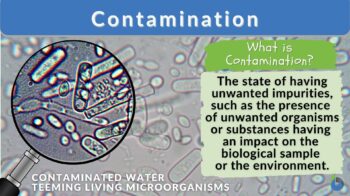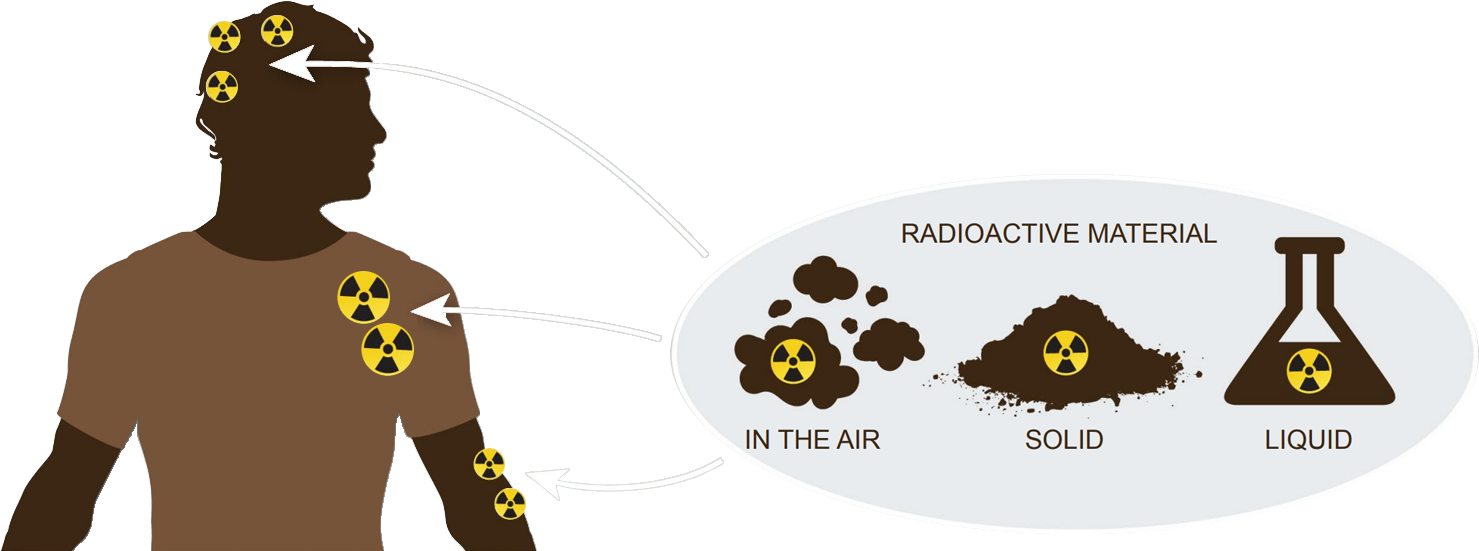
Contamination
n., plural: contaminations
[kənˌtæmɪˈneɪʃən]
Definition: The act or process of contaminating
Table of Contents
Contamination Definition
Contamination, sometimes interchanged with pollution, is the existence of live things or substances produced from bacteria, fungi, viruses, animals, and avian antigens that can have various negative impacts on health.
Watch this vid about biological contamination:
Biology definition:
Contamination refers to the soiling or pollution by inferior material, as by the introduction of organisms into a wound or sewage into a stream. It is also known as the presence of living creatures or agents originating from viruses, bacteria, fungi, and mammalian and avian antigens in the environment, which can produce a variety of health impacts.
Types Of Contamination
Depending on whether the contaminant is in a solid or liquid form and the environment it is found in, the word “contamination” can indicate different things in different scientific contexts. A contamination might even be more ethereal, like an unwelcome energy source that might obstruct a procedure.
There are various types of contamination in biology including:
- Chemical contamination
- Environmental contamination
- Food, beverage, and pharmaceutical contamination
- Radioactive contamination
- Interplanetary contamination
These and more will be explored in more detail below.
Chemical contamination
When chemicals are present in areas they shouldn’t be or at higher concentrations than they would have naturally occurred, it is said to be contaminated. This term is usually described as “chemical contamination”.
Both organic and inorganic compounds that are chemical contaminants can be discovered in mass-produced goods that practically everyone uses on a daily basis.
These include waste from landfill and incineration, as well as
- Plastics
- Resins
- Medicines
- Deodorants
- Deodorizers
- Detergents
- Petroleum products
- Road runoff
- Pesticides
- Biocides
Decomposition, neutralization, and physical processes can be used to decontaminate a substance chemically, but a thorough understanding of the underlying chemistry is necessary. Pharmaceutical and therapeutic contamination is infamously harmful and poses both perceptual and practical difficulties.
Environmental contamination
Environmental pollutants are chemicals that enter the environment accidentally or on purpose and this is because of human activity. Some of these pollutants may have been created for industrial purposes, and due to their high stability, they are difficult to decompose.
These toxins might get into the food chain if they are released into the environment. Other environmental pollutants include other chemicals that naturally occur; however, industrial activity may increase their mobility or the amount of them that is available to circulate in the environment, allowing them to enter the food chain at higher levels than would otherwise be possible.

Agricultural contamination
Water quality issues can arise from agricultural pollution in both surface and groundwater. Fertilizers and pesticides do not remain in the landscape after application; this is because these products are typically liquids that flow or seep into nearby areas. Instead, runoff and infiltration transport these pollutants into surrounding rivers, streams, and wells.
The land is also transformed to be optimal for agricultural production when it is transferred to agricultural usage. These alterations frequently have unanticipated environmental effects, such as changes in water quality (including drinking water) and quantity, on receiving waters and their ecosystems.
Commonly studied agricultural contaminants include:
- Pesticides,
- fungicides, insecticides
- Herbicides nutrients
- nitrogen and phosphorus
- Pesticides,
Food, beverage, and pharmaceutical contamination
Biological contamination refers to the occurrence of organisms (microbes, most especially) in food and/or drink. In other references, the definition extends to the contamination caused by the metabolic byproducts of these microorganisms.
Contamination of food and drink can happen in a variety of ways throughout operations like packing, sampling, production, storage, and transport. Cross-contamination, particle contamination, and microbiological contamination are the three main types of contamination that commonly impact the food and beverage sector.
When more than one type of food is produced at a facility and the equipment used to process those foods is not adequately cleaned, cross-contamination occurs during the manufacturing process. As a result, due to the inadequately cleaned equipment, contamination from one type of food is transferred to another type of food.
Particle and microbiological contamination, however, are much more pertinent to the problem at hand for air filtration. Particle contamination happens when minute airborne particles cling to open containers used to store food and beverages while they are being produced or packaged.
The lack of an efficient air filtering system that can remove many of the particulates before they land and combine with the food is almost usually to blame for this kind of contamination. However, food and beverage establishments must also be aware of how the structure and layout of their facilities may prevent or facilitate the incubation of dangerous particles in addition to air filters.
Microbial contamination, the third type of contamination, is the development of bacteria and mold. Employees that use poor sanitation practices may cause microbial contamination or moisture from leaks in the building may cause mold to grow over time. If not removed by efficient air filtering, many bacteria and mold can go airborne and create danger.
Radioactive contamination
When radioactive material is deposited on, inside of, or around an object or a person, radioactive contamination results. When radioactive materials are released into the environment, they have the potential to contaminate everything and anything in the environment. This includes the air itself, water bodies such as lakes, rivers, and seas, surfaces of items and structures, the soil, plants, and other living organisms including people and animals. A person who is said to be contaminated by radioactive material has radioactive elements inside their body or on their body.
Radioactive material can contaminate humans from the outside, and they can also contaminate surfaces they touch. For instance, individuals who have radioactive dust on their clothing run the risk of spreading the substance when they hug or sit in chairs.

Interplanetary contamination
Interplanetary contamination is the planned or accidental introduction of biological material into a planetary body by a space probe or spaceship.
The two types of interplanetary contamination are as follows:
- The transport of life and other types of pollution from Earth to another celestial body is known as forward contamination.
- Back contamination is the introduction of alien life and various types of contamination into the biosphere of the planet. If such habitats exist, it also covers extraterrestrial species infecting humans and human dwellings in space and on other celestial bodies.
Contaminated evidence
Evidence in forensic science can be tainted. When first responders or sources unrelated to the existing inquiry, such as the victim’s family or friends who are not suspects, contaminate fingerprints, hair, skin, or DNA, it may result in erroneous convictions, mistrials, or the dismissal of evidence.
Contaminated samples
In biological sciences, the accidental introduction of “foreign” material can significantly affect the outcome of investigations involving small samples. When the contaminant is a living bacterium, it might quickly proliferate and overwhelm the sample, rendering it worthless, as in infected cell culture lines. In geology, geochemistry, and archaeology, even a few grains of material can skew the results of complex experiments.
Food Contaminant Detection Method
Nuclear techniques can aid in the detection, monitoring, and tracking of pollutants in food. These are used by official government organizations (such as the united states government) and environmental protection agencies to ensure food is safe to consume.
More information can be found on secure websites that are safely connected, usually managed by government and official non-government organizations as this can be considered sensitive information. On these, you can find more resources and more examples about this public health issue.
- Microbiological contamination – To improve food safety in this area, a comprehensive approach to assessing chemical and other natural pollutants as well as microbiological dangers in the same foods is required, because the presence of a pathogenic food hazard in end-products indicates a failed process.
- Pesticides and other agrochemicals – Analytical laboratories are critical in pesticide residue monitoring and education on the safe and effective use of pesticides. Most developed countries and even other less developed ones have established various protocols for pesticide residues in foods.
- Veterinary drug residues – To ensure local and international consumers, they must be controlled by national monitoring programs coordinated by professional laboratories. Member States can better assist in the monitoring of veterinary drug residues and related pollutants in food and environmental samples with tools such as radio-receptor and -immunoassays, stable isotope-labeled veterinary medicines, and complementary chromatography technologies.
- Mycotoxins – Competent testing laboratories assist various countries with methods to improve their expertise in using radiometric and related analytical techniques. These will help to manage the poisons that mycotoxins possess.
- Radionuclides – Facilities capable of reliably determining natural radiation background levels.
- Metals and other organic contaminants – To protect human and environmental health, maximum limitations or codes of practice have been established. To ensure competent analysis and routine monitoring of these pollutants, professional testing laboratories are required.
Did you know …?
One of the most common forms of contamination is littering which is pollution caused by humans not disposing of their wastes in a proper manner.
Take the Contamination – Biology Quiz!
References
- Abzalov, M. (2016). Applied Mining Geology. Springer.
- Agricultural Contaminants | U.S. Geological Survey. (n.d.). Retrieved June 23, 2023, from https://www.usgs.gov/mission-areas/water-resources/science/agricultural-contaminants
- Biological contamination | InforMEA. (n.d.). Retrieved June 23, 2023, from https://www.informea.org/en/terms/biological-contamination
- Canada, H. (2008, January 31). Environmental Contaminants [Backgrounders;notices]. https://www.canada.ca/en/health-canada/services/food-nutrition/food-safety/chemical-contaminants/environmental-contaminants.html
- Chemical contamination. (2017, June 6). NIWA. https://niwa.co.nz/our-science/freshwater/tools/kaitiaki_tools/impacts/chemical-contaminates
- Cockell, C. S. (2005). Planetary protection-A microbial ethics approach. Space Policy, 21, 287–292. https://doi.org/10.1016/j.spacepol.2005.08.003
- Food and Beverage Contamination. (n.d.). Camfil. Retrieved June 23, 2023, from https://www.camfil.com/en/insights/food-and-beverage/food-and-beverage-contamination
- Food contaminants. (2016, April 13). [Text]. IAEA. https://www.iaea.org/topics/food-contaminants
- How DNA contamination can affect court cases | New Scientist. (n.d.). Retrieved June 23, 2023, from https://www.newscientist.com/article/mg21328475-000-how-dna-contamination-can-affect-court-cases/
- Introduction to Contamination Control and Cleanroom Technology—Matts Ramstorp—Google Books. (n.d.). Retrieved June 23, 2023, from https://books.google.dm/books?id=Hdk_KCSYdVIC&pg=PA20&redir_esc=y#v=onepage&q&f=false
- Radioactive Contamination and Radiation Exposure | CDC. (2023, February 27). https://www.cdc.gov/nceh/radiation/emergencies/contamination.htm
- Taupin, J. M. (2013). Introduction to Forensic DNA Evidence for Criminal Justice Professionals. CRC Press.
- Yarris, L., & Laboratory, L. B. N. (n.d.). Using microbial communities to assess environmental contamination. Retrieved June 23, 2023, from https://phys.org/news/2015-05-microbial-environmental-contamination.html
©BiologyOnline.com. Content provided and moderated by Biology Online Editors.


